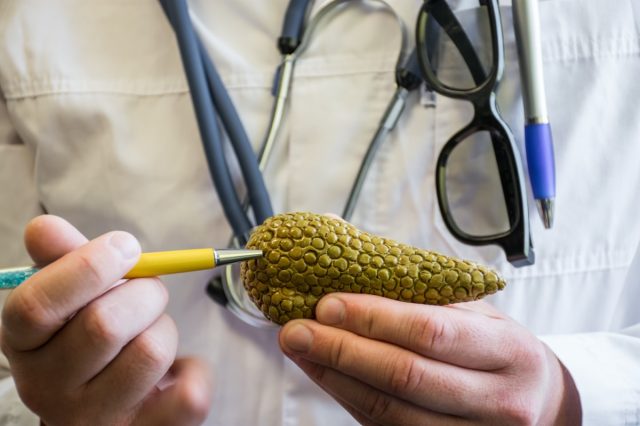Learn more about ‘What Are The Pancreatic Cancer Symptoms That Should Not Be Ignored?’ In the US, pancreatic cancer accounts for 7% of all cancer fatalities and 3% of all cancer diagnoses. Pancreatic cancer, sometimes referred to as the “silent killer,” is notoriously hard to detect.
According to studies, it can take a pancreatic tumor 12 to 15 years to become invasive, says Christopher Wolfgang, MD, PhD, director of the Perlmutter Cancer Center’s Division of Hepatobiliary and Pancreatic Surgery. “Surgery alone may be able to treat pancreatic cancer if we can identify and remove premalignant tumors inside that timeframe. The issue is that many early tumors cannot be seen.
On scans, we cannot spot them. We are creating diagnostic methods called liquid biopsies to find them in the blood. Cystic neoplasms are the tumors that can be seen on scans. The majority of these lesions are benign, but 3 to 5 percent will develop into cancer. Choosing which tumors to watch and which to remove surgically is difficult with these types of tumors. That’s a significant area of research, then.

Six particular gene alterations have been shown to be related to pancreatic cancer, according to study published in JAMA. According to Fergus Couch, PhD, “This study provides the most thorough data to date supporting genetic testing for all pancreatic cancer patients.” “Estimates of the degree of cancer risk correlated with each gene are presented for the first time in this study. It shows that family history is insufficient to determine who will carry these mutations.” Additionally, those without a history of the disease in their families have the mutations.
According to surgical oncologist Jin He, MD, PhD, “there are currently no straightforward diagnostics for pancreatic cancer.” The majority of instances are discovered when symptoms appear or when a CT or MRI scan is performed for another reason. A test for pancreatic cancer in the blood, urine, and stool is currently being developed at Johns Hopkins. Unfortunately, most cases of pancreatic cancer cannot be prevented; however, by maintaining a healthy weight, quitting smoking, and drinking in moderation, you can lower your risk.
Chronic pancreatitis and family history are additional risk factors. On rare occasions, precancerous lesions can be found and, if caught early enough, removed, can stop pancreatic cancer from occurring. Experts have identified seven symptoms of pancreatic cancer that are simple to miss.
Digestive Issues
According to doctors, unexplained digestive problems may be an indication of pancreatic cancer. According to the Pancreatic Cancer Action Network, persons with pancreatic cancer frequently experience poor appetite, indigestion, and nausea (PanCAN). When a pancreatic tumor pushes on the stomach or first section of the small intestine, some or all of these symptoms may manifest.
If this occurs, food may stay in the stomach and result in a number of digestive issues, such as nausea and vomiting. Other causes of digestive symptoms include changes in pancreatic enzyme production or blockages of the pancreatic duct through which the pancreatic enzymes pass.

Heinz-Josef Lenz, MD, an oncologist at USC Norris Comprehensive Cancer Center and a professor of medicine at the USC Keck School of Medicine, explains that when pancreatic juices are not flowing, digestion is incomplete, which can lead to bloating, a lack of appetite, and weight loss even if you are not trying to lose weight. You could notice that your feces and poop are darker than usual.
While bilirubin blockage might make feces appear lighter, excess bilirubin can make urine appear dark and brownish. According to Dr. Lenz, pancreatic cancer can stop the right enzymes from entering the intestines and breaking down fat, giving feces a greasier appearance.
Weight Loss
A typical sign of pancreatic cancer is weight loss. According to Christi M. Walsh ONC, MSN-CRNP, “People diagnosed with pancreatic cancer frequently find it challenging to maintain their weight and follow a balanced diet.” “The pancreas is an organ that may be found in the abdomen, behind the stomach, next to the duodenum, gallbladder, and small intestine. It is crucial for assisting in the process of transforming the food we eat into energy for the body’s cells. If the pancreas is not working due to cancer, food may not be digested properly.”

Walsh claims that weariness is a typical side effect of weight loss. “The exocrine, which aids in food digestion, and endocrine, which controls blood sugar, are the pancreas’ two primary roles. Patients who have pancreatic cancer lose weight and muscle mass while maintaining regular eating and digestion habits because the disease releases substances into the circulation that break down fat and muscle. Patients often experience tiredness.”
Jaundice
Another unnoticed sign of pancreatic cancer that appears when the condition is advanced is jaundice. According to Dr. Matthew Walsh, “One of the reasons is that the pancreas is a long organ that runs the length of your back from one side to the other, and depending on where in the pancreas it physically starts, in the geography of the pancreas, will determine what your symptoms are.”
Jaundice is one of the signs of a very tiny tumor that can develop in the very end of the pancreas, close to the entry to the duodenum. This can happen pretty early because a little tumor can clamp off the bile duct. But when you move away from that location geographically, you run the risk of developing a larger tumor that spreads undetected.
The majority of people will report to their usual doctor with jaundice or to the emergency department; after being assessed, it’s likely that they will get a scan and maybe receive a scope to assist treat the condition. And that’ll either give them a clear diagnosis because, in the case of jaundice, which is simply a blocked bile duct that results in yellowing of the skin and eyes and frequently extremely uncomfortable itching, you can perform a type of brush biopsy of a bile duct on a patient.
They’ll actually first detect it in their pee. It will turn black in your urine. So, if you experience those symptoms, you should see a doctor right away. And frequently, a family member rather than the patient is the one who notices it. So knowing that is always a good thing.
Sudden Diabetes Diagnosis
The fact that diabetes can be a sign of pancreatic cancer is not widely known. According to Suresh Chari, MD, “Long-standing diabetes is a (small) risk factor for pancreatic cancer.” “A small 1.5–2 times increase in risk results from it. As mentioned above, people who have had diabetes for longer than five years are thought to have a slightly higher than average risk of developing pancreatic cancer.
However, those who develop diabetes for the first time after the age of 50 have a nearly 1% chance of developing pancreatic cancer within three years of their diabetes diagnosis. In this instance, the diabetes was brought on by a pancreatic tumor.”
But how are diabetes and pancreatic cancer related? According to Dr. Chari, pancreatic cancer may make cells in the body more resistant to insulin, a vital hormone generated by the pancreas that aids in controlling blood sugar levels. “The insulin-producing cells in the pancreas produce more insulin in other insulin-resistant conditions (like obesity) to combat the insulin resistance. However, it appears that pancreatic cancer prevents the pancreas’ insulin-producing cells from adequately addressing this insulin resistance. Diabetes eventually develops as a result of this.
Diabetes is neither a symptom nor a risk factor for pancreatic neuroendocrine tumors (PNETs), despite the fact that these tumors develop from the pancreas’ hormone-producing cells. Both diabetes and pancreatic cancer can present with hazy symptoms that patients and physicians may disregard, yet both conditions can be far easier to manage if identified early and correctly. It’s critical that researchers and physicians create plans to guarantee that every patient receives an accurate diagnosis as soon as feasible.
Abdominal Pain
One of the most prevalent symptoms of pancreatic cancer is upper abdominal discomfort. According to Cancer Research UK, 70% of persons with pancreatic cancer see their doctors due of pain.
“Pancreatic body and tail tumors are more likely to cause pain. People describe it as a dull anguish that penetrates them deeply. It may start in the lower abdomen and move up to the back. Lying down makes the discomfort worse, whereas sitting up straight makes it go away. It can get worse after eating.”

“Pancreatic cancer has relatively few early warning symptoms, which makes it challenging to identify in its early stages. Symptoms may take considerably longer to manifest if the tumor is in the body or tail of the pancreas “Dr. Lenz explains. “This indicates that the tumor may become large before you experience back or abdominal pain. You should see a doctor if any of the listed symptoms appear and last for longer than a week.”











